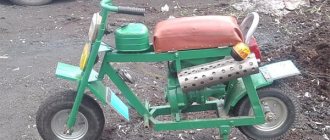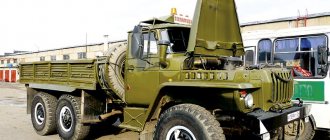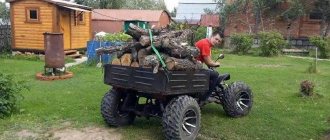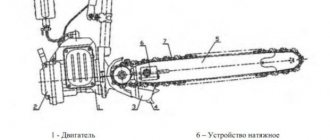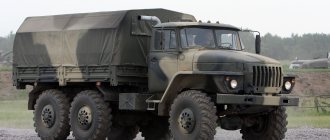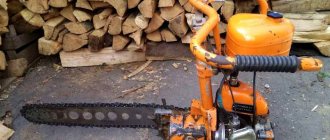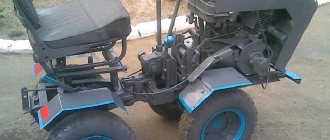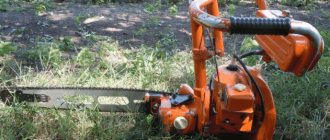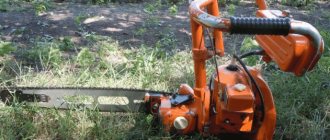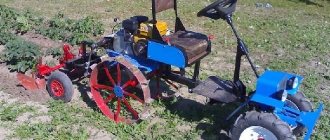Chainsaw Ural-2T (modification) Home Textbooks - Forestry
Site search
Chainsaw Ural-2T (modification)
At a summer cottage or in a household plot, there is always a need for small-scale mechanization equipment. You need a walk-behind tractor or cultivator for cultivating the soil, a motor pump for watering or extinguishing a fire, and a power station in case of a power outage, which happens quite often in rural areas. And if the dacha or house is located in close proximity to a body of water, then there is definitely a desire to have your own boat for fishing and water tourism with family or friends. But in all such cases you definitely need a gas engine. It is unrealistic to have your own gas engine on each unit. This is tens of thousands of rubles, which not everyone can afford. An alternative option is a universal engine converted from an existing domestically produced model. Its power can be comparable to the power of domestically produced walk-behind tractor engines - 5-6 hp. With. The presence of forced air cooling is mandatory, ignition is from a flywheel magneto. After familiarizing myself with quite a large number of domestically produced single-cylinder engines, I chose the Ural-2T-Electron chainsaw . Small-sized, lightweight, economical - it meets all the above requirements. Its motor life is comparable to the motor life of outboard outboard motors when constantly operating at maximum speed. The engine is equipped with a removable gearbox, which also contributes to its versatility, since depending on the load size, the presence of a gearbox or direct transmission allows for optimal matching of the engine and the load. And one more circumstance - currently the Ural-2T-Electron chainsaw is quite widespread among residents of rural areas. At the same time, the engine also has some shortcomings, the elimination of which predetermined the scope of its modernization. The engine of the Ural chainsaw is equipped with early ignition by the manufacturer, and a fixed ignition timing is ensured by aligning the marks on the engine crankcase and the magneto and by rigidly mounting the magneto itself on the crankcase. This is the simplest way to ensure the required ignition timing, which does not require the use of any additional parts, components, etc. At the same time, fixed ignition timing has many negative qualities - the need for high crankshaft speeds at startup (600 rpm), weak spark at startup, increased fuel consumption, inability to achieve maximum power, backfire, etc. As a result, starting the engine will be difficult, and engine operation at low speeds will be unstable. When starting a cold engine, you have to greatly enrich the working mixture, which inevitably leads to “flooding” of the spark plug, which, by the way, is mentioned in the operating instructions for the chainsaw. To avoid injury, the manual starter is designed to be easily removable - during the reverse flash, the starter cable is sharply retracted inside the housing and the starter jumps off the crankcase cover. Elimination of the listed disadvantages can be achieved by ensuring late ignition when starting the engine and operating it at low speeds and early ignition at medium and high speeds. Moreover, the ignition timing should increase in proportion to engine speed. The standard carburetor throttle control unit becomes unacceptable when altered and requires complete rework. When preparing the engine for conversion, the saw unit, drive sprocket, stop and steering wheel with a spring and articulated joint, gas tank and throttle control lever with cable, as well as the air filter, carburetor, carburetor casing, crankcase cover and deflector are removed from it.
Remaking the engine comes down to the manufacture and modification of the following components and parts:
1) crankcase covers to ensure permanent seating of the recoil starter;
2) a carburetor and installation of a more technologically advanced throttle control mechanism;
3) ignition systems and installation of an automatic ignition timing system;
4) clutches;
5) exhaust systems;
6) subframe for mounting the engine in place.
And now we will talk in detail about these works.
CRANKCASE COVER UPDATE
Since, as a result of the modification, the engine will be started with a late ignition, it makes sense to mount the manual starter rigidly on the crankcase cover, which will create certain operational conveniences. The central conical grille is removed from the crankcase cover. Using a drill d2-4 mm, holes are drilled on the lattice crosspieces. Then the jumpers between the holes are cut with a chisel, and the excess metal is removed with a semicircular file. On the end plane of the crankcase cover, marks are applied through the centers of the thickenings (where the jumpers of the conical grille were located) and the center of the resulting hole, and then they are continued on the side outer surface of the end platform. Moving 4 mm down from the end, horizontal marks are applied using a caliper. The resulting crosshairs are punched and holes d4.1 mm are drilled. The shoulders are removed from the seat ring of the manual starter and the metal is cut with a file until the same thickness is obtained all around. On the crankcase cover, the manual starter is installed with the handle in the desired direction. Having ensured that the holes on the side surface of the end plate of the crankcase cover do not touch the internal stiffeners of the manual starter housing, the latter is pulled with clamps to the crankcase cover. Through the already drilled holes d4.1 mm, using a drill of the same diameter, mark the centers of the holes on the seat ring of the manual starter. To do this, clamp the drill in the drill chuck, insert it into the hole and rotate the drill chuck manually with light pressure. The starter is released, the resulting holes are cored and through holes are made with a drill d4.1 mm. Install the starter in place, aligning the holes on the crankcase cover and the starter seat ring. M4x20 screws are inserted into the holes and tightened from the inside with nuts and split spring washers ( photo 1 ).
CARBURETOR UPDATE
Refinement of the carburetor includes the manufacture of a new idle speed control unit and a control unit for the engine crankshaft speed. To do this, remove the carburetor and all four screws securing the carburetor body. A piece 48 mm long is cut from an aluminum corner 20x20 mm and a console for fastening the adjustment unit is made according to Fig. 1 .
Chainsaw Ural repair and operation
In the process of using the Ural.2T Electron chainsaw, operational problems arise for various reasons that need to be eliminated. Problems almost always arise due to incorrect operation and can be corrected with your own hands. The article Chainsaw Ural, repair and operation is devoted to such typical problems that you can fix yourself, on your own.
Let's look at some of them below, the most serious at first glance (which I had to encounter during almost 15 years of using this tool), but easily removable on our own.
Such as, for example, repairing a starter or adjusting the ignition of a chainsaw, adjusting and installing a carburetor. Replacing the repair kit.
I purchased this tool in 1999, and it still works fine for me. And so, the first characteristic reason why the engine does not work as it should is the use of low-quality fuel.
The second reason is when too much oil is mixed with the fuel to operate the chainsaw. As a result, the engine does not produce the required power because:
1. The piston rings are burnt in the piston grooves, or the piston ring has broken.
2. The piston with piston rings and the cylinder are heavily contaminated with carbon deposits.
To fix this problem, you need to disassemble the chainsaw.
Photo-1. Remove the cylinder from the chainsaw body.
To do this, unscrew the nuts securing the cylinder to the body. Carefully remove the cylinder from the piston rings and carefully inspect the piston, rings and cylinder.
Photo-2. Carbon deposits on the piston and piston grooves.
Traces of heavy carbon deposits are visible on the piston and piston grooves, which should be removed. Carbon deposits are also present in such cases on the inside of the cylinder.
To remove carbon deposits from the piston grooves, it is necessary to remove the piston rings from the piston. The rings and piston are usually kept in kerosene or gasoline until the carbon deposits soften. Broken or heavily worn rings should be replaced with new ones.
To remove carbon deposits from the piston, you can use a wooden stick or rag, but not metal objects.
Photo-5. Removing carbon deposits from piston grooves.
To remove carbon deposits from the piston grooves, you should also use non-metallic objects. After removing carbon deposits or replacing the piston rings, reassemble the chainsaw in the reverse order.
Chainsaw gearbox Ural
If, while sawing a chainsaw, the gearbox makes a grinding noise or other extraneous sound, then it is necessary to disassemble and inspect it. It is quite possible that one of the two bevel gears of the gearbox has failed. The gearbox should be disassembled from the side of the saw chain drive sprocket.
Photo-10. Removing the drive sprocket. For more detailed information about the operating rules and methods of disassembling a chainsaw, download the instructions. DOWNLOAD
In order to remove the driving sprocket of the saw chain, you need to unscrew the fastening nut and pull the sprocket towards you. The sprocket should be carefully inspected, and if severe wear is detected, replace it with a new one.
Photo-11. Dismantling the driven bevel gear.
To dismantle the driven bevel gear of the gearbox, it is necessary to unscrew the fastening nuts and pull the gear housing towards you.
Photo-12. Replacing the driven bevel gear.
The driven bevel gear of the gearbox is inserted into an aluminum housing with a bearing. If necessary, the entire structure should be disassembled and worn parts replaced or the entire structure replaced.
If increased noise occurs when the chainsaw is operating, this may mean that the muffler has been damaged. In such cases, the muffler should be replaced.
To replace the chainsaw muffler, you need to unscrew the two M6 fastening nuts using a wrench, then unscrew the two M5 screws.
Photo-14. Unscrewing the M5 screw of the muffler.
To unscrew two M6 screws, use a screwdriver.
Models of chainsaws for conversion
We choose a model for remodeling - Ural, Druzhba, Husqvarna, Shtil. You can use an old tool with a worn saw blade.
The most popular option is the Druzhba saw, which has a simple device with a minimum number of components and components. The disadvantages include the heavy weight of the unit (12 kg) and the low level of safety. In addition, this technique is low-power 1 kW and is far from meeting the requirements of today - it is morally outdated even for creating a snowmobile from a chainsaw.
If we consider the Ural, then this is a more suitable modification, since it was originally developed as a powerful machine for felling forests. Therefore, in terms of technical parameters, the Ural is fully consistent with the expected loads on the snowmobile. With almost the same weight as Druzhba, the Ural saw is much more powerful - 3.7 kW.
A homemade snowmobile from a chainsaw, Shtil, Husqvarna, are very suitable options, given the sufficient power of 1.5 -3.0 kW with a low weight of 4 kg and the modern design of the tools.
Replacing the ratchet on a Ural chainsaw
Another reason for a chainsaw malfunction may be severe wear of the ratchet, which is installed on the flywheel bushing of the chainsaw's crankshaft. As a result of such a problem, it is not possible to start the chainsaw engine, since the starter ratchet does not engage the chainsaw ratchet. To do this, disassemble the deflector, remove the crankcase cover, then unscrew the ratchet and replace it with a new one.
To remove the deflector, you need to unscrew all its fastening nuts. But first you need to remove the frame with the gas tank, disconnect the gearbox from the engine, and also disconnect the gas line from the carburetor.
In order to remove the crankcase cover, you need to unscrew the fastening bolts, then carefully pull the cover towards you. Photo-8. Unscrewing the ratchet.
To remove the ratchet, it is necessary to block the rotation of the engine crankshaft. This can be achieved by blocking the friction clutch on the crankshaft on the reverse side (gearbox side).
The ratchet can be unscrewed easily; a wrench is used for this. All parts (deflector, crankcase cover) are assembled in the reverse order. That is, first the crankcase cover is installed and secured, then the deflector is installed and secured.
READ How to Make a Carriage for a Circular Machine on Bearings
Ural chainsaw engine
During the operation of the tool, it is very likely that the following problem may occur:
The engine starts with difficulty or normally, but runs unstably and intermittently. There are several probable reasons for such situations; we list the most basic ones below:
1. Poor quality fuel or water has entered the fuel.
2. Due to poor quality fuel the carburetor , from frequent attempts to start the engine, the spark plug became wet with fuel and a lot of fuel accumulated in the crankcase cavity.
3. Leaks in the connections between the cylinder and the crankcase, and depressurization may also occur between the carburetor and the cylinder.
4. Rarely, but still happens, depressurization of the chainsaw crankcase.
Methods for eliminating such causes are as follows:
If the reason is low-quality fuel, then you should drain all remaining low-quality fuel from the gas tank. Clean the gas line, disassemble the carburetor, clean the carburetor strainer from debris and reassemble it, reinstall it. Adjust the carburetor as follows:
1.Turn the carburetor full throttle screw all the way and then turn it back 1/2 turn.
2.Tighten the idle screw until it stops, then turn it out one turn.
Leaks in the connection of the cylinder to the crankcase or the carburetor to the chainsaw body are eliminated by tightening the fastening nuts. The spark plug should be unscrewed, dried and cleaned. Gasoline from the crankcase cavity must be purged as follows:
Close the fuel valve, then unscrew the spark plug, install the starter and pull out the starter cable, then release it back. This operation is repeated many times until all the fuel accumulated in the crankcase is purged (the fuel flies out through the spark plug installation hole on the cylinder).
To restore the tightness of the chainsaw crankcase, you need to disassemble it. To do this, first of all you need to disassemble the drive clutch.
In order to remove the bearing cover, it is necessary to unscrew the fastening nuts without damaging the gasket. Then remove the adjusting ring that is installed between the bearing and the cover.
We continue dismantling, you need to unscrew the five nuts from the studs and separate the left side of the crankcase from the right side.
In this case, as a rule, the gasket always fails, since it is paper. Next, you should draw another gasket on drawing paper, then lubricate it with oil and install it back on the studs.
Photo-19. Installing a new gasket on the studs.
We install a new gasket made of drawing paper on the crankcase mounting studs, then remove it back and lubricate it with oil.
Photo-20. Connection of the left side of the crankcase to the right.
After this, we install it back on the studs, then install the second part of the crankcase and secure it with fastening nuts. Disassembling the engine crankcase is carried out not only when it is necessary to replace the gasket, but also when replacing worn bearings, as well as the connecting rod and piston group. Read more article Ural chainsaw
WE RECOMMEND you to repost the article on social networks!
Power station
For a mobile power plant with a power of up to 5 kW, there is a time-tested solution: a homemade generator based on a motor from a Druzhba or Ural saw. They are actively used on expeditions and at remote logging sites. The device includes a steel frame, welded from a corner, on which an engine, a generator and a waterproof electrical distribution box with sockets for connecting electrical equipment or an extension cord are mounted. Through the gearbox, torque is transmitted to the generator shaft.
For low-speed generators, there is an option for a homemade power station with a belt drive. This design is smaller in size.
Adjusting the carburetor of Ural chainsaws
Before leaving the factory, all chainsaws receive factory settings, which are retained for a certain time. After purchasing new equipment, the question of how to adjust the carburetor on a Ural chainsaw becomes central. Do not rush to reconfigure the carburetor after purchase: let the saw run for several hours at low speeds. Gradually adjusting the jet clockwise, switch to high speeds, during which the saw should not buzz or smoke much. If this happens, tighten the screw: the fuel mixture will become leaner. By following this adjustment principle, the saw can always be adapted to any load.
Purpose
In the USSR, 2 models of chainsaws were mass-produced - the Ural and Druzhba, and there was also the Parma electric saw. The Druzhba model was planned for small farms and was a “folk” product, and the Ural model was positioned as a professional-level tool intended for logging on an industrial scale.
Although in general these two saws are very similar, the Ural, as a more professional tool, has the ability to rotate the blade to a horizontal position in order to cut down a tree trunk while standing and not put so much strain on the operator’s back.
The use of the Urals in everyday life or at work greatly facilitates the already physically difficult work of loggers. This chainsaw can not only cut down trees, but also use it as an assistant in construction and household work, dismantling, bucking, and sawing firewood.
How to start a Ural chainsaw?
A serviceable and refilled tool can be started. To do this you need:
- move the switch to the working position;
- pump the fuel mixture into the carburetor;
- pull the starter;
- warm up the engine and start working.
If the device is completely new or returned from repair, it definitely needs to be broken in, which we’ll talk about next.
Setting the maximum power
Power adjustment on the Ural 2 Electron chainsaw is carried out only after the break-in period has expired (it is 25 hours of operation) and after adjusting the idle speed.
READ How to Remove the Chuck from a Whirlwind Screwdriver
The essence of the setting comes down to depleting or enriching the fuel mixture.
Not fully tightening the propeller means introducing more air and less fuel. When the screw is unscrewed, the opposite happens, that is, the combustible mixture becomes richer. The most preferred position of the screws can only be determined experimentally.
When setting up the Ural , you must remember the following principles for the correct operation of the chainsaw:
- The engine should always have good cutting performance and smoke should be moderate.
- The engine should always have excellent throttle response. At the same time, during the process of cutting wood, the chain should not stop, the saw should not overheat, and the engine should not slow down on its own.
If a complete misadjustment of the carburetor occurs and the engine stops starting, it is recommended to perform the following actions:
- The screw is turned completely until it stops, and then turned out one turn, no more.
- The screw is tightened to the limit, and then turned out half a turn.
This will allow you to return the adjusting screws to their original position, and then carry out proper adjustment of the carburetor of the Ural chainsaw according to the standards described above.
Types of sawmills
The most widespread today are the following three types of devices for sawing logs with a chainsaw with your own hands, which differ in their design:
- Tire.
- Tape.
- Disc sawmill.
https://youtube.com/watch?v=XR_TrDiAqQU
Disk installations
The relatively simple design of disc installations makes them easy for most homeowners. Due to their ease of assembly and versatility, these types of woodworking machines are most widespread and are found everywhere. The basis of this design will be a circular saw, which is mounted on the spindle of an electric motor. Additionally, a strong base is made, above or below which a shaft with a saw and an electric motor are fixed.
A durable and reliable frame for a disk unit can be made of metal or wooden parts that are welded or fastened together with nails and screws. The work table can be made of sheet metal; you just need to ensure the ideal geometry of the structure, which allows you to guarantee the highest possible quality of wood cutting.
The use of disc saws allows you to make slats of various sizes, produce timber, veneer, and cut boards to the required length and width. Thanks to the high rotation speed of the saw, it is possible to ensure that logs are cut with smooth, high-quality edges and cuts.
Band sawmill
Belt-type installations combine simplicity of design and excellent performance. Accordingly, they are popular not only in everyday life, but are also widely used in sawmills and enterprises that produce lumber. The advantages of this type of equipment include its high productivity, as well as the ability to cut large logs weighing more than 300 kilograms.
To make a band sawmill you will need the following:
- Pulleys.
- Channel.
- Metal corners.
- Pipes with different diameters and sizes.
- Metal structures for the production of sleepers.
The production of such a sawmill begins with the construction of a frame, which has the shape of the letter P and is made of a corner or channel with dimensions of 50 by 100 millimeters. The standard dimensions of the frame are a length of 8 meters and a height of at least 15 centimeters. To increase the strength of the base, the channels are additionally tightened with pipes and angles, which will allow the base to withstand the maximum possible load.
Next, they begin to build the mobile cart. For this, a steel plate is used, the thickness of which is 40 millimeters. An electric motor will be responsible for driving the trolley, the power of which should be 10-12 kW.
A saw is attached to the trolley with a chain drive, which is fixed to the electric motor shaft through a pulley. A handle-steering wheel is welded to the side of the movable cart, which will be responsible for moving the mobile structure along a fixed base.
https://youtube.com/watch?v=MVx1lq1COng
Tire sawmills
Tire sawmills or logosols differ in their design from other similar devices. Using this manual technique, you can longitudinally saw logs, producing high-quality slats and veneer. Thanks to its compact dimensions, logosol can be installed both outdoors and inside a small workshop or wooden shed. At such a sawmill it will be possible not only to cut logs, but also to produce small-sized workpieces with a non-standard shape.
Having a high-quality sawmill diagram in hand and choosing the correct length of the chainsaw blade, you can independently create a machine that will provide high-quality sawing of logs. It will be possible to decide how to make a sawmill with your own hands, saving on the purchase of components for equipment.
What kind of carburetor is used in the Ural chainsaw
Ural 2 Electron chainsaws are equipped with a KMP-100U carburetor, famous for its reliability and ease of adjustment. The body is completely metal, the jets are calibrated, and the membrane is made of a material resistant to a mixture of gasoline and oil.
To quickly start the chainsaw at subzero temperatures, the carburetor is equipped with a cold engine start lever. As for adjusting the quality and quantity of the fuel mixture, screws are responsible for this, which you can independently set to the desired position.
boat motor
The saw set is removed from the chain saw engine and the drive sprocket is removed. The clutch is remade by grinding out a smaller cup and replacing the tension spring, which makes it possible to reduce the mass of the unit and reduce the adhesion force. The motor shaft and gearbox are connected through a coupling.
For installation use a channel:
- in the top shelf the necessary holes are made for mounting the engine with the gearbox;
- The lower shelf is equipped with a hole, a tube is welded into it coaxially with the output shaft of the gearbox.
A shaft is passed through the tube, which transmits rotation to the propeller, and is connected to the output shaft of the gearbox. A fastening and rotating unit is attached to it, which is used to install the motor on the transom of the boat, raising and lowering the propeller into the water.
A gearbox is installed at the lower end of the tube, which receives rotation from the vertical shaft and transmits it to the horizontal one. A propeller is installed on the latter, which will move the boat.
How does a carburetor work on a Ural chainsaw?
The design of the carburetor cannot be called complex, which is definitely an advantage of the Ural 2 Electron chainsaws. The main components responsible for the performance of the carburetor include:
- A float chamber made in the form of a reservoir. This element is used to maintain the fuel level at an optimal level before mixing with air occurs.
- Channels through which the fuel mixture enters. From the float chamber, the fuel is initially transported to the nozzle, and then enters the atomizer.
- A diffuser, which is a narrowed tube. With the help of this element, the rate of entry of air masses is increased to obtain a high-quality fuel mixture.
- A special tube resembling an aerodynamic design. This is the main element of the carburetor through which air masses pass. This tube is equipped with a special damper that regulates the amount of air supplied.
Setting idle speed
Before proceeding with the adjustment, you should make sure that:
- The engine runs smoothly and the chain does not move.
- There is no strong smoke.
The adjustment algorithm looks like this:
- The Ural saw engine starts and warms up a little. The screw sets the minimum speed so that the chain remains in place. If the mixture is too rich (strong smoke coming from the exhaust pipe), then the screw should be tightened a little. This will reduce smoke and increase speed.
- Then you need to return all settings to the level of minimum and stable speed. This is done by partially unscrewing the screw
- The next step is to test the engine for throttle response. If, after pressing the throttle lever firmly, the revolutions quickly go up, then everything is done correctly, and the screw must be securely fixed in this position.
If the engine stops working or the speed increases slowly, the screw should be turned out a little. In order to increase the speed, the screw is turned a little. Afterwards, the Ural saw engine is re-checked for throttle response.
Step-by-step instructions for making a snowmobile from a Druzhba chainsaw
As has already been said many times, the manufacturing process depends on the chosen design option and drawing. There are complex schemes, but there is one fairly simple option using a regular snow scooter as the basis for the design. It is captivating because it already has a ready-made supporting base, steering and a completely comfortable seat. The task is to strengthen the side skis, as well as mount the engine, transmission and track to the frame.
Step-by-step assembly instructions:
- First of all, it is necessary to strengthen the side skis. This can be done by welding a profile or pipes to them. The support bearings of the front and rear tension shafts are also attached to them. The size of the reinforcing base depends on the diameter of the front shaft. For best grip, the bottom of the shaft should be level with the skis.
- The next stage is the manufacture of the track mounting frame. It is made from a corner and a profile pipe measuring 30x30 mm. The length of the frame is taken to calculate the dimensions of the frame for mounting the engine with a gas tank in the rear of the snow scooter. The width is within the width of the snow scooter.
- The track is tensioned using shafts. It works on the principle of tensioning the chain in a chainsaw. The tension shaft is moved by a bolt, which in turn is fixed to the frame. As tension shafts, you can use tubeless wheels from hand trucks, rollers from agricultural machinery, or make them by hand cutting them out of plastic. It is also necessary to install support rollers for the caterpillar, only without a tensioning mechanism. They are made in the same way as tension ones. To ensure the required clearance and prevent the rollers from moving, insert bushings are installed on the axle.
- The caterpillar is made of a conveyor belt with a thickness of at least 3 mm. Gear wheels from the Buran snowmobile are mounted on the tension shafts in the center. The tape is cut into two parts and placed along the edges. Between the pieces there is a distance commensurate with the width of the gears. Hitch tracks can be made from halves of a plastic water pipe or an aluminum profile. The thickness of the tracks is recommended to be more than 5 mm. The tracks are fastened with bolts or rivets. The gap between the tracks should correspond to the pitch of the gear wheels from the Buran.
- A platform with an engine is still mounted on the back of the snow scooter. A gas tank is also installed on it. A drive sprocket is mounted on the drive shaft, and a sprocket is also mounted on the engine. The power transmission is carried out by the drive chain. To ensure chain tension, the frame with the engine must be movable, the sprockets must be at the same level.
- After securing the main parts to ensure safety during operation, the moving parts of the snowmobile are covered with protective covers made of metal or plastic.
When the carburetor needs adjustment
All new Ural 2 Electron chainsaws supplied by the manufacturer have already undergone standard carburetor adjustment at the factory. However, for proper running-in of the tool, it would be useful to purposefully lower the engine speed, and then make fine adjustments. This process allows the engine to operate as efficiently as possible.
In addition, after a certain period, the carburetor settings of the Ural chainsaw are lost. But this is natural, since various difficulties may arise during operation. Symptoms indicating the need to adjust the fuel mixture supply and preparation system include:
- Increased gasoline consumption. This is caused by oversaturation of the fuel mixture with gasoline.
- Engine stalling or not starting at all. In this case, the cause is excess air and shortage of gasoline.
If everything is in order with the fuel mixture, it means that the Ural chainsaw carburetor adjustment failure is caused by mechanical reasons:
- Strong vibration. The protective cap becomes damaged over time, causing the adjusting screws to move randomly.
- Blockage. The use of low-quality fuel, damage to the filter element, the appearance of scale - all this contributes to the appearance of blockages. There is no way to do this without completely disassembling, cleaning the entire system and reconfiguring it.
- Worn piston and cylinder. If the problem is that the piston part of the engine has become unusable, then adjusting the carburetor will only help temporarily.
Homemade options
The first thing that comes to mind when you think about what can be done with a chainsaw is its use as a sawmill. Many developers had to split logs onto beams with this tool.
Holding the saw suspended in your hands, it is very difficult to control the accuracy of the entire length of the cut. Therefore, with a log length of three or four meters, it moves far away from the intended line. This problem can be solved quite simply. To do this, the chainsaw is rigidly fixed to a frame, which moves along a guide profile.
Refinement of the Ural chainsaw carburetor: eliminating factory defects
Since the KMP-100 carburetor was the only one produced in the USSR, several million of them were produced. With such a massive and long-term production, the product could not be raw and unfinished. All the shortcomings were taken into account and improved at the beginning of production, and the KMP-100 and KMP-100U had no factory, design or technological shortcomings.
All their problems arise from improper operation (low-quality fuel) or simply from physical wear and tear over time.
carburetor requires modification when the engine from the Ural 2t Electron chainsaw is used for another purpose. For example, like a boat motor.
In this case, it is not the carburetor itself that needs to be altered, but the idle speed control system located on the gas handle.
Walbro carburetor for Ural chainsaw
carburetor from the Stihl MS 660 chainsaw, which is similar in power, has proven itself well. A perfect fit is achieved by adjusting the screws. Also, the mounting dimensions are almost identical (between the holes on the carburetor and the studs on the engine). A difference of 1 mm is eliminated by sharpening both holes with a file, each by 0.5 mm.
This is what a Walbro carburetor looks like, which is installed on a Ural chainsaw
Gasoline winch
With this attachment, the saw "with a slight movement of the hand" turns... the saw... turns into an elegant and compact pulling device!
A similar cable winch, with a force of over 2 tons, can lift loads on an inclined plane, as well as move quite massive objects horizontally (by dragging and on rollers). For example, trawling harvested logs.
The range of the device depends on the length of the standard cable. Manufacturers usually limit themselves to 30-50 meters, but this is enough to be able to attach a plow, hiller (or other types of attachments) and process/plow a rather large area.
The power of a chainsaw with a winch is enough to move a passenger car, so quite often this attachment in one version or another is used by car enthusiasts.
What other carburetors were installed on the Ural 2t Electron chainsaw?
The Ural 2t Electron chainsaw was often equipped, and is installed today, with carburetors from other two-stroke engines with the following engine parameters:
- power 5.5 hp
- combustion chamber volume 90.4 cc,
- piston diameter 55 mm.
Sometimes carburetors from much more powerful engines were installed. For example, from motorcycles “Minsk”, “Voskhod”. True, there is a drawback: the supply of the fuel-air mixture increases significantly. It was reduced by adjusting the screws. The engine worked, but the excessive fuel consumption was significant.
With the appearance on sale, after 1991, of imported chainsaws and spare parts for them of similar power, carburetors from them began to be used.
We choose a saw according to its characteristics depending on the purpose
It is generally accepted that everything is determined by the class of the chainsaw. There are household, semi-professional and professional models, which essentially characterizes the scope of use. But such a choice will still be superficial, since within the same class a tool can differ significantly. And first of all – technical characteristics. They determine the performance and endurance of the models, as well as the duration of work. By comparing the parameters with the tasks and conditions in which you will work, you will be able to make the right choice. We present to your attention the main characteristics specified by tool manufacturers.
Engine power and displacement
The power of a chainsaw is calculated in horsepower. But for the convenience of comparing gasoline and electric models, it is customary to indicate it in kilowatts - after all, this unit of measurement is an indicator of output power. Of course, this parameter depends on the engine size. For example, for models with an engine capacity of up to 50 cc. cm power is no more than 2 kW , for a tool with an internal combustion engine volume of 70 cubic meters. cm - 3 kW , for equipment with an engine capacity of 90 cubic meters. cm – 6 kW . It’s easy to guess: the more massive the instrument, the more powerful it is, i.e. Suitable for longer sawing times. Let's say you need a chainsaw for infrequent work on a personal plot or in the household to prepare firewood, for example, for a bathhouse, for stove heating, etc. Surely you will work no more than 2 - 3 hours a day . A low power model is suitable for you - from 0.7 to 2 kW. When it comes to large-scale work, for example, sawing several cubic meters of slabs or trimming logs, preparing material for construction or carrying out work to improve the urban landscape, you will have to work for up to 3–5 hours . It is better to choose a chainsaw with a power of 2.5 to 3 kW. At logging enterprises and when felling trees in the forest, you have to cut almost without a break the entire working day - up to 8 hours . The optimal solution would be a professional saw with a power of 4 - 6 kW.
Tire length
This parameter determines how thick the log can be cut in one go. Again, we need to start from the upcoming tasks. Are you planning to cut down branches or not very thick trees, or cut boards for private construction? Take a tool with a bar 25 - 35 cm long. With compact equipment it will be easier for you to handle. For felling work, equipment with a working part of 50–60 cm is suitable. You will spend less time and effort on each trunk. The length of the bar is not equal to the width of the workpiece, which can be cut in one go. For example, a chainsaw with a working part of 40 cm is capable of working with logs no thicker than 35 cm.
Fuel tank volume
The characteristic affects the duration of work without refueling. Due to the fact that a large tank significantly increases the design of the saw, most models are equipped with a tank from 0.2 to 0.5 liters. Professional models, designed for continuous use throughout the working day, have a tank volume of 0.8 - 1.3 liters. Powerful equipment needs more fuel.
Weight
Depending on the engine size, dimensions and length of the tire, the weight of the equipment is determined. It is logical that a lightweight chainsaw is more convenient. But if you need a powerful, productive tool, you will have to sacrifice comfort - the weight of a professional model can reach 7 - 9 kg. For household ones, this parameter is 4 – 5 kg.
Noise level
The sound of a running power tool has a negative impact on the hearing organs. As a rule, the noise level of most saws is 105 - 115 dB, and for safety reasons, you should wear noise-protective headphones while working. Now many manufacturers are trying to make chainsaws quieter. There are a number of models in which the noise level does not exceed 100 dB, for example, Efco 162 - 100 dB, ECHO CS-3700ES-16″ - 98 dB.
For reference: a sound level of 100 dB is similar to, for example, the movement of a subway car or the sound of thunder. According to European standards, this value is the maximum for the player’s headphones.
So, the capabilities of the chainsaw and the purposes for which it is suitable depend on the technical characteristics. But that's not all you need to consider when purchasing. It is very important that the tool is easy and comfortable to work with.
Repair: main faults and their elimination
Most often, problems with fuel supply arise when the tiny holes of the jets become clogged and when the membrane-rocker arm pair fails. The brass cross of the rocker arm can bend or jump out of its seat and shut off the fuel supply at the wrong time. The soft membrane can dry out over time, lose elasticity, warp and also incorrectly shut off the fuel supply.
This is what the new membrane looks like (right)
There are two ways to clean the nozzle hole:
- The carburetor is purged with compressed air from a compressor or pump. Remove the gasoline supply hose from the tank, put an air hose on the fitting and bleed the carburetor.
- If the problem is not solved, remove it, disassemble it, gain access to the jets, clean and rinse the entire chainsaw carburetor. The jet is cleaned in place or unscrewed (it is threaded).
The soft membrane on old carburetors most often fails after long breaks in operation. It just dries out without gasoline. Therefore, before starting after a long period of inactivity (a year or six months in the summer in the heat), you need to open the gas tank tap, fill the carburetor of the Ural chainsaw with gasoline, and do a test run after half an hour.
If the carburetor is several decades old, the membrane material can change its properties simply over time.
A defective membrane cannot be repaired; it is simply replaced.
Lack of tightness
Other problems with the KMP-100U carburetor are loss of tightness. Gaskets between the carburetor and the engine body, and between parts of the carburetor should not suck in air during operation and cause fuel leaks when the engine is turned off.
Gaskets can deteriorate for the same reasons as the membrane, that is, they dry out and become brittle over time.
Repair kit for Ural chainsaw carburetor
Repair kits are still sold for KMP-100U carburetors - a set of gaskets, a membrane, in other configurations there may also be a rocker arm with a spring for it.
The spring that determines the position of the rocker arm must under no circumstances be stretched. The cross of the rocker arm must lie exactly, strictly parallel to the plane of the carburetor, otherwise the fuel supply will be incorrect.
During the Soviet era, when not only chainsaws were in short supply, but also spare parts for them, gaskets were made ourselves, from paronite sheets.
In the absence of paronitis, the gaskets were made of thick single-layer paper (not cardboard), coated with oil paint.
Sources:
https://sadovij-instrument.ru/benzopily/ural.html https://benzopilok.ru/remont/karbyurator/regulirovka-na-benzopile-ural.html https://vsekarby.ru/benzoinstrument/benzopily/karbyurator- ural.html
Auger, auger body, drive
Let's move on to the working parts of the Ural snow blower, namely the auger. It is made from a piece of pipe of small diameter. You can also use any shafts up to 80-850 mm long. An important condition is the selection of bearings for the shaft. This length of the shaft is needed to provide its drive, which will be located outside the housing.
Next, you need to cut 4 circles with an outer diameter of 300 mm from sheet metal 2-3 mm thick. Holes with a diameter of 220-230 mm are cut in these circles. Next, the existing disks are cut on one side and at the cut site the disk is stretched, forming something like a coil of a spring. This must be done with all 4 blanks.
The prepared screw bands are welded on one side to the blades, on the other side spacers are attached to the shaft, to which the other ends of the bands are welded. The ribbons need to be positioned so that their turns move toward the center. That is, on both sides of the blades there should be two tapes installed in parallel and with their turns directed towards the center. Moreover, this entire structure should not exceed 700 mm in length; the rest of the shaft will go under the drive.
Photo of the auger mechanism of a homemade snow blower
Let's move on to the body. It is made from round sidewalls, which in diameter should exceed the auger by about 50-70 mm. Next, a sheet of metal 1-1.5 mm thick is taken. It bends along the circumference of the sidewalls and is welded to them, forming a semicircle. Holes are made in the center of the sides into which the finished auger is inserted. From the outside of the sidewalls, bearings are put on the shaft, pressed against the sidewalls and secured, while the position of the shaft is centered. To secure the bearings to the sidewalls, you can make races, or simply weld them to the sidewalls with external races, but then the structure will not be dismountable.
Next you need to make a snow drain. It can be made from a piece of aluminum pipe with a diameter of 150 mm and a length of 100 mm, as well as pieces of sheet metal from which you will need to form a box. The pipe section will be the basis of the snow guide. To install it, a hole of the required diameter is made in the auger body, located so that it is slightly behind the auger blades. A piece of pipe is inserted into the hole and secured in it with a bolted connection, and the prepared box is attached to the pipe.
